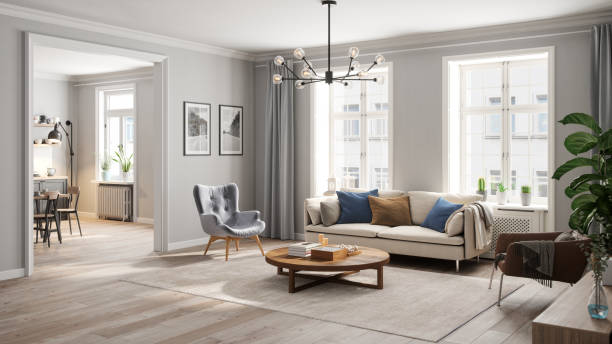Creating a Home That Sings: The Essentials of Designing Inviting Living Spaces
Contents
Key Takeaways
- Discover the core principles of designing inviting living spaces.
- Learn how to blend functionality with aesthetics for enhanced home comfort.
- Understand the importance of lighting, furniture, and decor in home design.
- Access valuable resources for further reading on home design trends and tips.
Table of Contents
- Introduction to Inviting Living Spaces
- The Role of Lighting in Home Design
- Choosing the Right Furniture
- Creating Functional Yet Stylish Decor Schemes
- The Impact of Color Harmony
- Maximizing Space in Small Living Areas
- Modern Trends in Home Design
- Conclusion: Bringing It All Together
Introduction to Inviting Living Spaces
Crafting an inviting living space is an art that balances style and functionality. Whether you’re refurbishing a small studio or redesigning a spacious family home, the goal is to create a harmonious blend of comfort and aesthetics that welcomes you whenever you enter the door.
Every space holds vast potential, waiting to be unlocked through thoughtful decoration and strategic arrangement. The essence of a welcoming living space lies in crafting an environment that feels both personal and universally appealing, reflecting individual tastes while accommodating the needs of everyday life. This balance ensures a living area not only captivates the eye but also serves as a sanctuary for relaxation and functionality.
The Role of Lighting in Home Design
Lighting is more than a mere necessity; it’s a design tool that can dramatically alter the mood and perception of your home. By thoughtfully layering lighting—combining ambient, task, and accent lights—you can create a dynamic space adaptable to various activities and times of the day. Understanding how to use lighting enhances visibility, accentuates architectural features, creates shadows that add depth, and highlights focal points in the decor. For professional guidance, consider consulting experienced experts such as the Manhattan Beach real estate team Caskey Real Estate Group, who possess deep insights into the art of home styling and decor. For inspiration on the latest advancements, explore lighting trends and technologies from industry leaders, which can help transform your rooms into cozy and inviting sanctuaries.
Choosing the Right Furniture
Furniture serves as the backbone of any living space, dictating the flow and functionality of the room. Selecting the right pieces involves more than just picking items that fit; it’s about ensuring that every piece contributes positively to the ambiance and practicality of the room. Consider aspects such as the size of the furniture in the room, the comfort it offers, and how it blends with the surrounding colors and themes. Well-chosen furniture not only elevates the style of the room but also supports the activities that take place within it, making it an integral component of a balanced and effective home design.
Creating Functional Yet Stylish Decor Schemes
The decor is where your style shines through, offering opportunities to inject creativity and individuality into your home. The key is to balance aesthetics with functionality, ensuring that every decorative element adds value to the space. Rugs can define areas within a room, artwork can add character and color, and purposefully chosen trinkets can tell a story. Functionality should never be compromised; each item should have a role, whether contributing to the visual appeal or aiding in the room’s utility. The result is a decor scheme that feels seamless and intentional, enhancing the day-to-day experience of the living space.
The Impact of Color Harmony
Color harmony is a pivotal aspect of home design that can significantly influence the look and feel of a space. Different colors evoke different emotions, and understanding the psychology behind them can help you create a cohesive and inviting environment. For instance, cool colors like blue and green can create a calming atmosphere, while warm colors like red and orange can add energy and warmth. To help guide color choices, principles of color harmony suggest paying attention to the balance and contrast of hues, tones, and shades, ensuring a visually pleasing and emotionally resonant space.
Maximizing Space in Small Living Areas
Even the most minor living areas can feel expansive with the right strategies. Employing multifunctional furniture—such as a sofa that doubles as a bed or a coffee table with storage—can optimize the utility of a room. Vertical storage solutions, like floating shelves, can take advantage of wall space, reducing clutter and freeing up floor space. The arrangement of these elements should prioritize practicality without sacrificing aesthetic appeal, emphasizing clean lines and open pathways that trick the eye into perceiving more space than is physically available.
Modern Trends in Home Design
Home design is ever-evolving, with modern trends providing fresh inspiration and innovation. There is a significant push towards sustainable materials and energy-efficient designs that resonate with eco-conscious consumers. Minimalism remains popular, celebrating simplicity and uncluttered spaces. Smart technology integration, from automated lighting systems to energy-efficient appliances, also transforms homes into intelligent and adaptable environments. These trends enhance living spaces’ visual and practical aspects and align the home with a broader shift towards eco-friendly and connected living.
Conclusion: Bringing It All Together
Designing an inviting home is about creating a symphony of aesthetics, personal style, and functional living tailored to your needs. Whether you’re updating an existing space or starting anew, these guiding principles can assist in crafting a home that feels both timeless and uniquely yours. The art of blending style with comfort ensures that your home will be striking to the senses and a haven where you can unwind with ease and joy.

